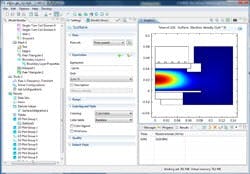Plasma Simulation Module Available For Wide Range Of Industries
Comsol’s Plasma Module is designed for researchers, engineers and experimentalists in the field of plasma science to model non-equilibrium discharges, which occur in a wide range of engineering disciplines.
Target application areas utilizing plasmas include light sources, semiconductor processes, surface coating, and medical sterilization. The module is accompanied by a suite of tutorial and industrially relevant models, which serve as both instructional examples and a foundation for future work.
Low-temperature plasmas represent the amalgamation of fluid mechanics, reaction engineering, physical kinetics, heat transfer, mass transfer and electromagnetics. The net result is a true multiphysics problem involving advanced couplings between the different physics. The Plasma Module features application-specific physics interfaces that automatically implements the complicated coupling between each of the components that make up plasma.
There are specialized modeling interfaces for the most common types of plasma reactors including inductively coupled plasmas (ICP), DC discharges, wave heated discharges (microwave plasmas) and capacitively coupled plasmas (CCP). Each of the interfaces can be customized, modified and extended in arbitrary ways by the user.
Modeling the interaction between the plasma and an external electrical circuit is an important part of understanding the electrical characteristics of a discharge. The Plasma Module provides tools to add circuit elements directly to a 1-D, 2-D or 3-D model. Alternatively users can import an existing SPICE netlist into the model. The plasma chemistry is specified either by loading in sets of collision cross sections from a file, or by adding reactions and species directly in the user interface.





